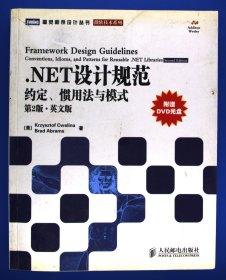
.NET设计规范:约定、惯用法与模式
¥ 7.14 1.2折 ¥ 59 八五品
仅1件
作者[美]克瓦林纳、[美]艾布拉姆斯 著
出版社人民邮电出版社
出版时间2010-01
版次1
装帧平装
上书时间2024-11-15
- 最新上架
商品详情
- 品相描述:八五品
图书标准信息
- 作者 [美]克瓦林纳、[美]艾布拉姆斯 著
- 出版社 人民邮电出版社
- 出版时间 2010-01
- 版次 1
- ISBN 9787115214454
- 定价 59.00元
- 装帧 平装
- 开本 16开
- 纸张 胶版纸
- 页数 443页
- 字数 557千字
- 正文语种 英语
- 丛书 图灵程序设计丛书·微软技术系列
- 【内容简介】
-
《.NET设计规范:约定、惯用法与模式(第2版·英文版)》关注直接影响框架可编程能力的设计问题,为框架设计师和广大开发人员设计高质量的软件提供了权威的指南,这一版更新至.NET3.5。书中内容涉及框架设计的基本原则和规范,常用设计惯用法,为命名空间、类型、成员等框架各部分命名的规范,框架中常用设计模式的规范等。同时,书中添加了来自经验丰富的框架设计师、业界专家及用户给出的评注,为书中的许多规范增色不少。
《.NET设计规范:约定、惯用法与模式(第2版·英文版)》为框架设计师必读之作,也可用作.NET开发人员的技术参考书。 - 【作者简介】
-
克瓦琳娜(KrzysztofCwalina),微软公司.NETFranmwork开发组项目经理。他为.NETFramework设计了多个API。还开发了FxCop等框架开发工具。目前,他正致力于在微软内部开发推广设计规范。将其应用到.NETFramework中。同时负责核心.NETFrameworkAPI的交付。
艾布拉姆斯(BradAbrams),微软公司CLR开发组和.NETFramework开发组的创始人之一,目前是项目经理主管。他参与制定了CLS、.NETFramework设计规范以及ECMA/ISOCLI标准中程序库标准。著有Programminginthe.NETEnvironment、.NETFrameworkStandardLibraryAnnotatedReference(卷1和卷2)等书。 - 【目录】
-
1 Introduction
1.1 QualitiesofaWell-DesignedFramework
1.1.1 Well-DesignedFrameworksAreSimple
1.1.2 Well-DesignedFrameworksAreExpensivetoDesign
1.1.3 Well-DesignedFrameworksAreFullofTrade-Offs
1.1.4 Well-DesignedFrameworksBorrowfromthePast
1.1.5 Well-DesignedFrameworksAreDesignedtoEvolve
1.1.6 Well-DesignedFrameworksAreIntegrated
1.1.7 Well-DesignedFrameworksAreConsistent
2 FrameworkDesignFundamentals
2.1 ProgressiveFrameworks
2.2 FundamentalPrinciplesofFrameworkDesign
2.2.1 ThePrincipleofScenario-DrivenDesign
2.2.2 ThePrincipleofLowBarriertoEntry
2.2.3 ThePrincipleofSelf-DocumentingObjectModels
2.2.4 ThePrincipleofLayeredArchitecture
3 NamingGuidelines
3.1 CapitalizationConventions
3.1.1 CapitalizationRulesforIdentifiers
3.1.2 CapitalizingAcronyms
3.1.3 CapitalizingCompoundWordsandCommonTerms
3.1.4 CaseSensitivity
3.2 GeneralNamingConventions
3.2.1 WordChoice
3.2.2 UsingAbbreviationsandAcronyms
3.2.3 AvoidingLanguage-SpecificNames
3.2.4 NamingNewVersionsofExistingAPIs
3.3 NamesofAssembliesandDLLs
3.4 NamesofNamespaces
3.4.1 NamespacesandTypeNameConflicts
3.5 NamesofClasses,Structs,andInterfaces
3.5.1 NamesofGenericTypeParameters
3.5.2 NamesofCommonTypes
3.5.3 NamingEnumerations
3.6 NamesofTypeMembers
3.6.1 NamesofMethods
3.6.2 NamesofProperties
3.6.3 NamesofEvents
3.6.4 NamingFields
3.7 NamingParameters
3.7.1 NamingOperatorOverloadParameters
3.8 NamingResources
4 TypeDesignGuidelines
4.1TypesandNamespaces
4.1.1 StandardSubnamespaceNames
4.2 ChoosingBetweenClassandStruct
4.3 ChoosingBetweenClassandInterface
4.4 AbstractClassDesign
4.5 StaticClassDesign
4.6 InterfaceDesign
4.7 StructDesign
4.8 EnumDesign
4.8.1 DesigningFlagEnums
4.8.2 AddingValuestoEnums
4.9 NestedTypes
4.10 TypesandAssemblyMetadata
5 MemberDesign
5.1 GeneralMemberDesignGuidelines
5.1.1 MemberOverloading
5.1.2 ImplementingInterfaceMembersExplicitly
5.1.3 ChoosingBetweenPropertiesandMethods
5.2 PropertyDesign
5.2.1 IndexedPropertyDesign
5.2.2 PropertyChangeNotificationEvents
5.3 ConstructorDesign
5.3.1 TypeConstructorGuidelines
5.4 EventDesign
5.4.1 CustomEventHandlerDesign
5.5 FieldDesign
5.6 ExtensionMethods
5.7 OperatorOverloads
5.7.1 OverloadingOperator==
5.7.2 ConversionOperators
5.8 ParameterDesign
5.8.1 ChoosingBetweenEnumandBooleanParameters
5.8.2 ValidatingArguments
5.8.3 ParameterPassing
5.8.4 MemberswithVariableNumberofParameters
5.8.5 PointerParameters
6 DesigningforExtensibility
6.1 ExtensibilityMechanisms
6.1.1 UnsealedClasses
6.1.2 ProtectedMembers
6.1.3 EventsandCallbacks
6.1.4 VirtualMembers
6.1.5 Abstractions(AbstractTypesandInterfaces)
6.2 BaseClasses
6.3 Sealing
7 Exceptions
7.1 ExceptionThrowing
7.2 ChoosingtheRightTypeofExceptiontoThrow
7.2.1 ErrorMessageDesign
7.2.2 ExceptionHandling
7.2.3 WrappingExceptions
7.3 UsingStandardExceptionTypes
7.3.1 ExceptConandSystemExcept~on
7.3.2 AppL~cat~onExcept~on
7.3.3 InvaL~dOperat~onExceptCon
7.3.4 ArgumentExcept~on,ArgumentNuLLExcept~on,andArgumentOutOfRangeExcept~on
7.3.5 NuLLReferenceExcept~on,IndexOutOfRangeExcept~on,andAccessVCoLatConExcept~on
7.3.6 StackOverfLowExcept~on
7.3.7 utOfMemoryExcept~on
7.3.8 ComExcept~on,SEHExceptCon,andExecut~onEng~ne-Exception
7.4 DesigningCustomExceptions
7.5 ExceptionsandPerformance
7.5.1 Tester-DoerPattern
7.5.2 Try-ParsePattern
8 UsageGuidelines
8.1 Arrays
8.2 Attributes
8.3 Collections
8.3.1 CollectionParameters
8.3.2 CollectionPropertiesandReturnValues
8.3.3 ChoosingBetweenArraysandCollections
8.3.4 ImplementingCustomCollections
8.4 DateTimeandDateTimeOffset
8.5 ICloneable
8.6 IComparableandIEquatable
8.7 IDisposable
8.8 Nuiiable
8.9 Object
8.9.1 Object.EquaLs
8.9.2 Object.GetHashCode
8.9.3 Object.ToStrlng271
8.10 Serialization
8.10.1 ChoosingtheRightSerializationTechnologytoSupport
8.10.2 SupportingDataContractSerialization
8.10.3 SupportingXMLSerialization
8.10.4 SupportingRuntimeSerialization
8.11 UrL283
8.11.1 System.Urn.ImplementationGuidelines
8.12 System.XmlUsage
8.13 EqualityOperators
8.13.1 EqualityOperatorsonValueTypes
8.13.2 EqualityOperatorsonReferenceTypes
9 CommonDesignPatterns
9.1 AggregateComponents
9.1.1 Component-OrientedDesign
9.1.2 FactoredTypes
9.1.3 AggregateComponentGuidelines
9.2 TheAsyncPatterns
9.2.1 ChoosingBetweentheAsyncPatterns
9.2.2 ClassicAsyncPattern
9.2.3 ClassicAsyncPatternBasicImplementationExample
9.2.4 Event-BasedAsyncPattern
9.2.5 SupportingOutandRefParameters
9.2.6 SupportingCancellation
9.2.7 SupportingProgressReporting
9.2.8 SupportingIncrementalResults
9.3 DependencyProperties
9.3.1 DependencyPropertyDesign
9.3.2 AttachedDependencyPropertyDesign
9.3.3 DependencyPropertyValidation
9.3.4 DependencyPropertyChangeNotifications
9.3.5 DependencyPropertyValueCoercion
9.4 DisposePattern
9.4.1 BasicDisposePattern
9.4.2 FinalizableTypes
9.5 Factories
9.6 LINQSupport
9.6.1 OverviewofLINQ
9.6.2 WaysofImplementingLINQSupport
9.6.3 SupportingLINQthroughIEnumerabLe
9.6.4 SupportingLINQthroughIOueryabLe~T~
9.6.5 SupportingLINQthroughtheQueryPattern
9.7 OptionalFeaturePattern
9.8 SimulatingCovariance
9.9 TemplateMethod
9.10 Timeouts
9.11 XAMLReadableTypes
9.12 AndintheEnd...
A C#CodingStyleConventions
A.1 GeneralStyleConventions
A.1.1 BraceUsage
A.1.2 SpaceUsage
A.1.3 IndentUsage
A.1.4 Other367
A.2 NamingConventions
A.3 Comments
A.4 FileOrganization
B UsingFxCoptoEnforcetheFrameworkDesignGuidelines
B.1 WhatIsFxCop?
B.2 TheEvolutionofFxCop
B.3 HowDoesItWork?
B.4 FxCopGuidelineCoverage
B.4.1 FxCopRulesfortheNamingGuidelines
B.4.2 FxCopRulesfortheTypeDesignGuidelines
B.4.3 FxCopRulesforMemberDesign
B.4.4 FxCopRulesforDesigningforExtensibility
B.4.5 FxCopRulesforExceptions
B.4.6 FxCopRulesforUsageGuidelines
B.4.7 FxCopRulesforDesignPatterns
C SampleAPISpecification
Glossary
SuggestedReadingList
Index
相关推荐
-

NET设计规范:约定、惯用法与模式
全新北京
¥ 21.48
-

NET设计规范:约定、惯用法与模式
全新北京
¥ 21.68
-

NET设计规范:约定、惯用法与模式
全新廊坊
¥ 22.42
-

NET设计规范:约定、惯用法与模式
全新保定
¥ 21.46
-

.NET设计规范:约定、惯用法与模式
九五品天津
¥ 12.50
-

.NET设计规范:约定、惯用法与模式
全新保定
¥ 23.20
-

.NET设计规范:约定、惯用法与模式
全新保定
¥ 23.10
-

.NET设计规范:约定、惯用法与模式
九五品廊坊
¥ 24.26
-

.NET设计规范:约定、惯用法与模式
九品北京
¥ 20.58
-

.NET设计规范:约定、惯用法与模式
全新北京
¥ 21.83
— 没有更多了 —














以下为对购买帮助不大的评价